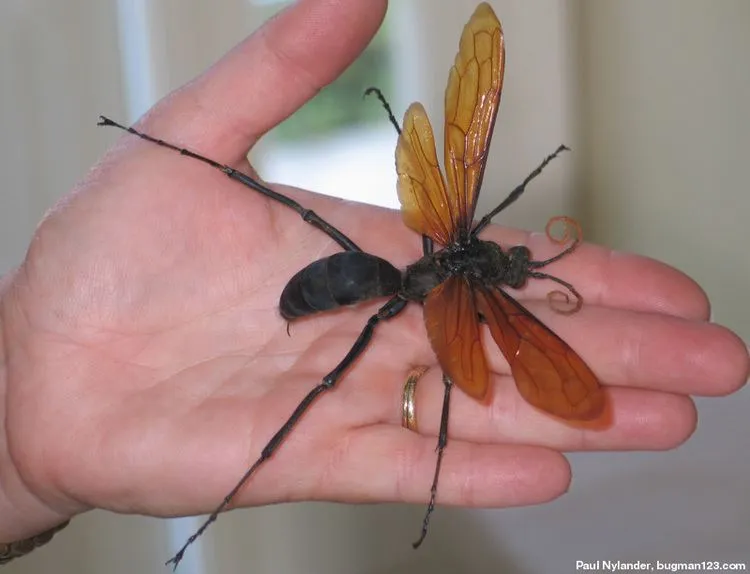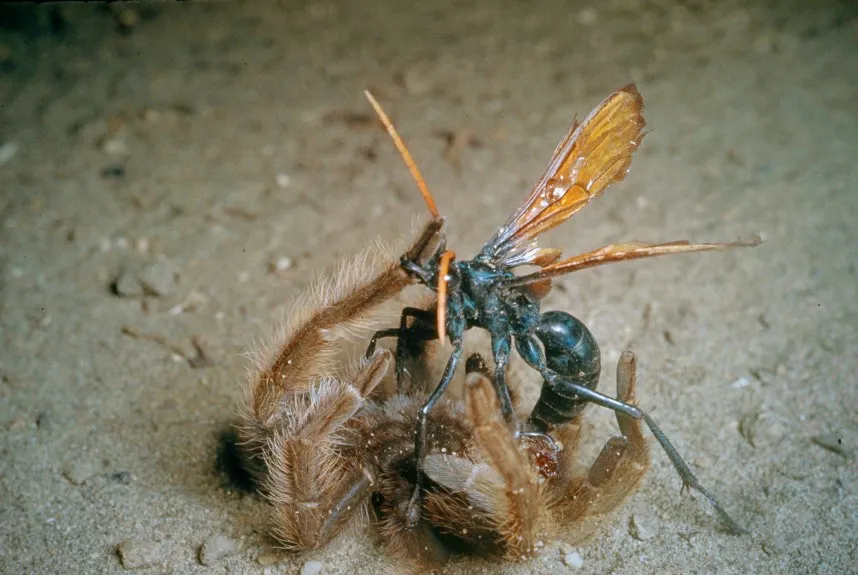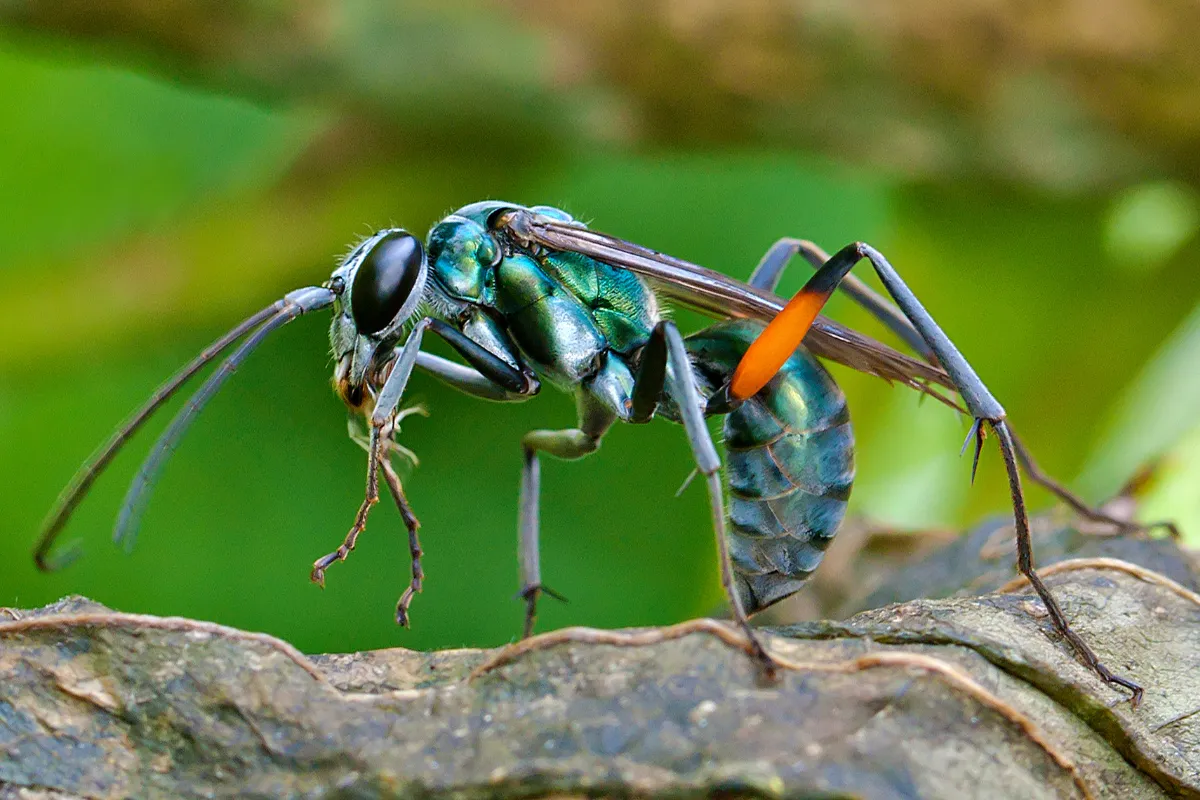What Are Tarantula Hawks?
Tarantula Hawks are among the largest wasps on Earth, known for their formidable size, striking appearance, and a venomous sting considered one of the most painful in the insect world. These impressive insects are a part of the Pompilidae family, which is known for its spider-hunting behavior. The name ‘Tarantula Hawk’ is derived from their predatory habits, as they specifically target tarantulas. They are primarily found in the southwestern United States, where they thrive in arid and semi-arid environments. The lifecycle of a tarantula hawk is quite fascinating, involving a unique interaction between the wasp and its prey. The female tarantula hawk hunts the tarantula, paralyzing it with a sting before dragging it to a burrow. She then lays a single egg on the spider’s abdomen. When the egg hatches, the larva consumes the still-living spider, providing a unique example of parasitoidism. The wasp larva then pupates inside the spider’s body, eventually emerging as an adult tarantula hawk, restarting the cycle. These wasps play a vital role in controlling the tarantula population, acting as natural predators. This interaction showcases the intricate balance of nature and the fascinating adaptations found within the insect world.
Understanding Tarantula Hawks
To fully appreciate the threats they face, understanding tarantula hawks is essential. These wasps possess several characteristics, starting with their distinctive appearance. They have a vibrant coloration, typically featuring a black body and orange wings. The combination of the colours is an aposematic signal, warning potential predators of their powerful sting. Their size is another key attribute, with females often measuring up to two inches long, making them one of the largest wasps. Beyond their appearance, their behaviour is equally important. They are solitary creatures, with females responsible for hunting and nesting, while the males primarily focus on mating. Their powerful sting is not just for defense; it’s also a tool to paralyze their prey. This paralysis is crucial for their reproductive cycle, as it allows them to lay eggs on the immobile tarantula. The sting itself is infamously painful, often described as one of the most agonizing insect stings. Despite this, they are generally not aggressive towards humans and will only sting if provoked or threatened. This complex interplay of physical attributes and behavioral traits makes tarantula hawks a fascinating subject of study.
The Tarantula Hawk’s Sting

The sting of a tarantula hawk is not merely a defensive mechanism; it is a sophisticated tool finely tuned to the wasp’s predatory lifestyle. This sting is delivered through a potent venom that targets the nervous system of its victims, which is typically a tarantula. When the wasp attacks a tarantula, it stings the spider, injecting a venom that paralyzes the spider. The effect of the sting is almost immediate, rendering the tarantula immobile. The paralyzing effect is temporary, allowing the tarantula to remain alive while serving as a host for the wasp larva. The pain associated with the sting is legendary, often described as an intense, burning sensation that can last for several minutes. The pain is so excruciating that entomologists have described it as one of the most painful stings in the insect world. The sting serves a crucial role in the wasp’s reproductive cycle and is a testament to the efficiency of natural selection in creating specialized adaptations for survival.
Top 5 Predators of Tarantula Hawks
Despite their formidable sting and size, tarantula hawks are not invincible and face several threats in their environment. These threats are not as numerous as those faced by smaller insects but can significantly affect their population and survival rates. Here are the top 5 predators of tarantula hawks, each playing a part in controlling their numbers. While they are relatively well-protected by their sting, certain animals have evolved strategies to overcome their defenses, or are simply opportunistic predators. These natural enemies range from birds and reptiles to other insects and parasites, each representing a different challenge to the tarantula hawk’s survival. Understanding these predators is crucial for appreciating the challenges tarantula hawks face in their natural habitat.
Birds
Birds, being opportunistic predators, can pose a threat to tarantula hawks. Larger birds of prey, such as hawks and falcons, might attempt to catch them in flight. Birds have a range of strategies for dealing with stinging insects. Some species are adept at capturing insects mid-air, while others may target them on the ground. Birds may also use techniques like shaking or battering the wasps to neutralize the sting before consuming them. Their speed and aerial prowess provide a clear advantage. The threat from birds is particularly high during the wasps’ active periods when they are foraging or mating. While the tarantula hawks’ sting offers some protection, birds can still pose a significant risk, contributing to the overall natural mortality rate of these impressive insects.
Lizards and Reptiles

Reptiles, particularly lizards, can also prey on tarantula hawks, presenting a significant threat to these wasps. Lizards are known for their ambush-hunting techniques, and they can quickly snatch insects when they get close. They are common predators in the same habitats as the tarantula hawks. Lizards often have tough skin and scales, providing some protection from stings, although the tarantula hawk’s sting can still be painful and potentially incapacitating. Lizards usually have a fast reaction time and agility, allowing them to catch wasps mid-flight or when they are resting. Because lizards are a common part of the ecosystem in the southwestern United States, where tarantula hawks are found, they pose a frequent threat. Reptiles, like lizards, are more than capable of hunting and consuming tarantula hawks, contributing to the wasps’ mortality.
Mammals
Some mammals are predators of tarantula hawks, though this is less common than predation by birds or reptiles. Mammals like opossums and skunks might occasionally prey on them. These mammals are opportunistic eaters and will consume insects if they are available. Mammals may be more vulnerable to the sting, but their fur can provide some protection. Some mammals might learn to avoid stinging insects, while others are less sensitive to their effects. These animals can pose a risk to tarantula hawks during their foraging activities, or when the wasps are nesting near the ground. While not a primary predator, the presence of mammals in the tarantula hawks’ habitat adds to the threats they face, impacting the wasps’ survival rates.
Other Insects and Arachnids
Besides birds, reptiles, and mammals, other insects and arachnids can be predators of tarantula hawks. Some larger spiders or other predatory wasps may attack and consume them. These insects may be able to overcome the wasp’s defenses through their speed, agility, or specialized hunting techniques. These interactions can result in competition for resources. The constant threat from other insects and arachnids adds to the complexity of the tarantula hawk’s environment. These predatory insects can directly impact the survival of tarantula hawks, contributing to their mortality and influencing their population dynamics. This highlights the fierce competition in their environment.
Parasites and Diseases

Parasites and diseases can also be a threat to tarantula hawks, indirectly affecting their survival. Parasites can weaken the wasps, making them more vulnerable to other predators. Fungal infections, viruses, or other diseases can also spread through tarantula hawk populations, causing significant mortality. These diseases and parasitic infestations can be particularly dangerous when the wasps are stressed or in areas with high insect densities. Parasites can have a major impact on individual tarantula hawks, reducing their ability to hunt or reproduce. Diseases may also reduce the population’s numbers. These factors demonstrate how diseases and parasites play an important role in the natural balance of the tarantula hawks’ environment.
How to Protect Tarantula Hawks
Protecting tarantula hawks involves understanding their habitat needs and the threats they face. Conservation efforts can help ensure the wasps’ continued survival. Maintaining their natural habitats is crucial. Supporting a healthy ecosystem that includes diverse plant life and natural prey sources is essential. Minimizing the use of pesticides can help protect these beneficial insects. Because they are natural predators, reducing pesticide use will also prevent the harm to the tarantula hawks’ food supply. Educating people about the ecological role of tarantula hawks and the importance of biodiversity is important. By protecting these beautiful and important insects, we can help ensure the continued health of their environment, supporting these fascinating wasps for generations to come.
